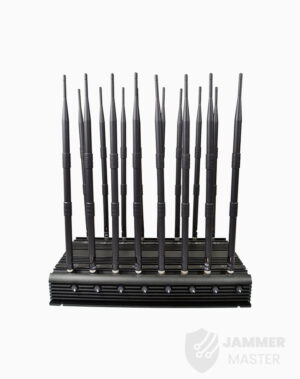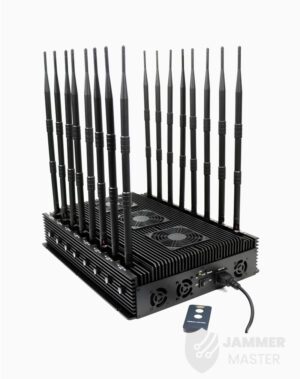
How to Block Drones with a Drone Jammer
In an age where the sky is dotted with drones, the importance of drone jammers has never been more significant. From commercial deliveries to personal

In certain situations, the use of mobile phones can cause significant disruptions. To address this issue, the installation of Cell Phone Jammers in places where phone usage is prohibited has become a popular solution. However, it is crucial to consider the effective range of these jammers and whether there are any blind spots or leakage points within this range. Additionally, factors such as operational reliability, interference with external signals, and cost should also be taken into account when selecting and installing Cell Phone Jammers.

5G Mobile Phone Jammer JM023 Block Cellular/GPS/RC/LoJack
$980.00
16 Antennas Signal Jammer Block Multiple Frequencies JM002
$1,088.99
Desktop 5G Cellular Signal Jammer Block Cellular/Wireless/GPS/LoJack JM006
$1,839.99
Desktop All-in-One Signal Jammer Block Full Band Cellular/WiFi/GPS/LOJACK JM014
$899.00The effective range of a Cell Phone Jammer refers to the area within which it can successfully disrupt phone signals. However, the presence of nearby mobile network base stations can affect the interference range. To achieve optimal jamming results, it may be necessary to invest in more powerful jammers, which can significantly increase costs. Therefore, it is essential to assess the interference range requirements and potential external interference before selecting a suitable jammer.
The operational reliability of a Cell Phone Jammer refers to its ability to function without any faults or malfunctions. While most jammers come with a one-year warranty, it is crucial to consider their actual stability and longevity. If a jammer can operate reliably for three years instead of the guaranteed one-year warranty period, the cost-effectiveness of the device increases significantly. On the other hand, frequent malfunctions during the warranty period can lead to unforeseen risks, wastage of resources, and a decrease in cost-effectiveness and user experience.
When considering the interference caused by Cell Phone Jammers, it is important to ensure that they do not disrupt external signals. While increasing the jamming power can effectively disrupt phone signals, it may also result in significant interference with external signals. Therefore, it is crucial to carefully design and control the jamming technology to achieve precise and efficient signal blocking without causing interference to the surrounding environment.
The cost of Cell Phone Jammers should align with the interference requirements and budget constraints. It is important not to blindly choose cheaper products or assume that higher-priced jammers offer better shielding effects. The effectiveness of the jamming device and its past performance should be thoroughly evaluated through on-site inspections and testing before making a final selection.
Installing Cell Phone Jammers in areas where phone usage is prohibited can effectively address the challenges posed by mobile phones. However, several factors need to be considered to ensure the successful implementation of these jammers. These include evaluating the effective range and potential interference, assessing the operational reliability, minimizing interference with external signals, and selecting a jammer that offers the desired cost-effectiveness. By carefully considering these factors, one can ensure the efficient and effective use of Cell Phone Jammers in various settings.
Our frequency checker tool will help you check all frequency bands used in all country.

In an age where the sky is dotted with drones, the importance of drone jammers has never been more significant. From commercial deliveries to personal

Protect your vehicle’s location privacy with a professional guide on GPS jammers. From selection to legal considerations and installation tips, we’ve got you covered. Key

Here’s a step by step guide on how to build your own GPS jammer. Below are the main steps we are going to introduce in

Understanding Signal Blocker: How It Works and Its Applications Signal Blockers are devices that can disrupt mobile phone signals, preventing them from connecting to base

The Application and Benefits of High-Power Signal Jammers Enhancing Signal Blocking Efficiency in Various Environments In today’s technologically advanced world, the need for effective signal

Considerations for Purchasing Exam Room Signal Jammers Ensuring Effective Signal Jamming for Exam Integrity As the year approaches its end, many schools are preparing for

The Importance of Monitoring and Signal Interference Measures During Examinations During examination periods, it is crucial to closely monitor the examination venues and their surrounding

Selecting the Appropriate Cell Phone Jammer for Theaters and Auditoriums Overcoming Challenges in Installation and Maximizing Signal Disruption The Importance of Cell Phone Jamming in

Remote Control of Cell Phone Jammers via Smartphone: A Possibility? With the rapid development of the Internet of Things (IoT), numerous smart home devices have

Supplying high quality signal jamming devices since 2010. The only jammer store you can trust.
Jammer Master © 2024. Premium Signal Jammer Supplier Since 2010.